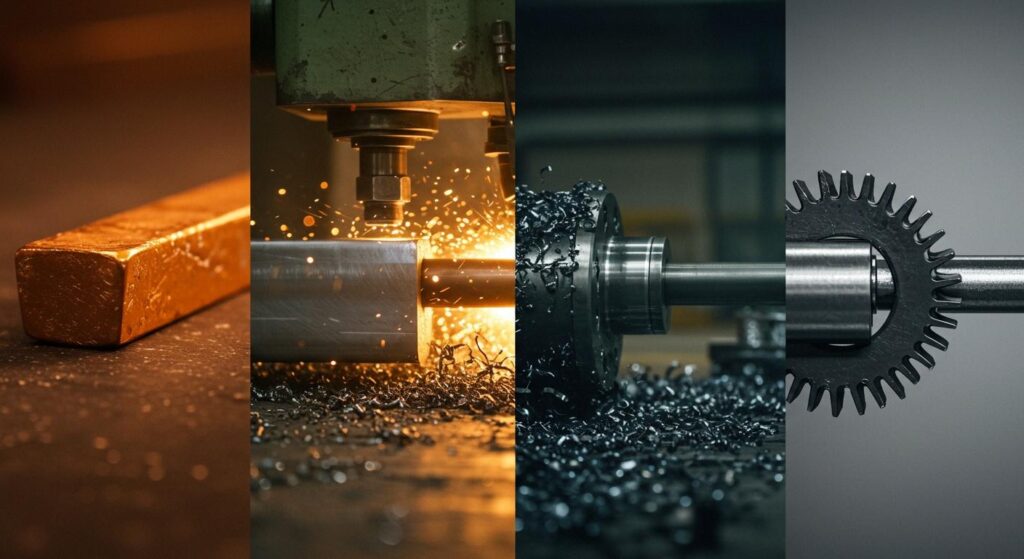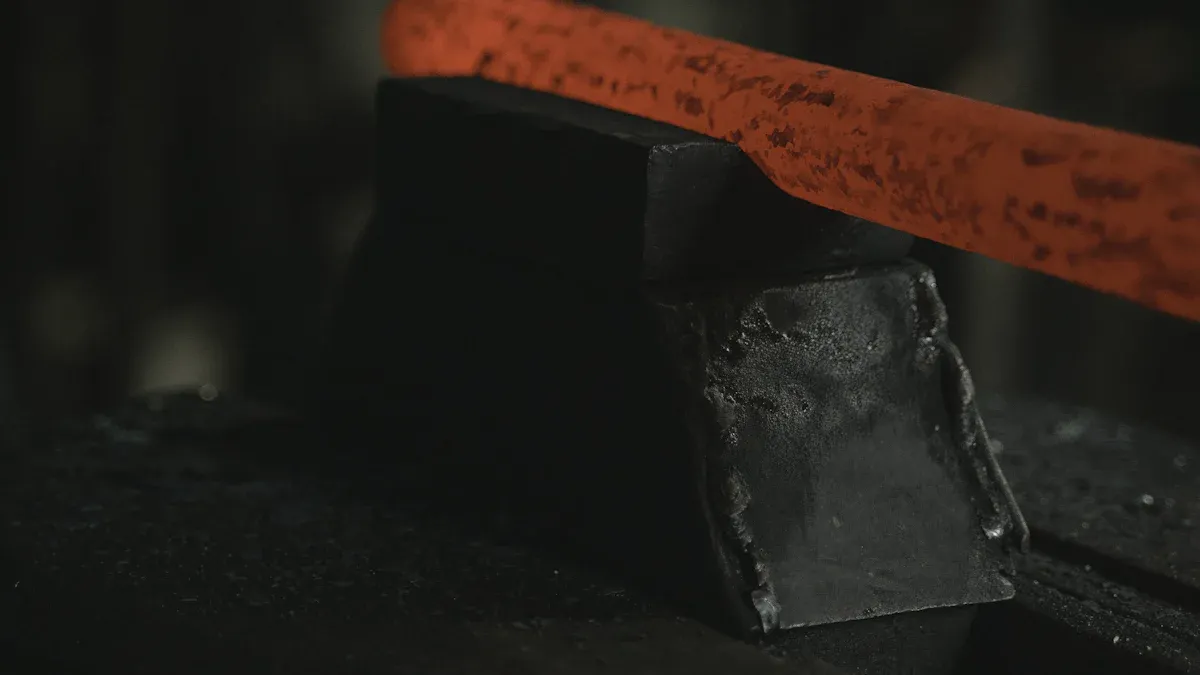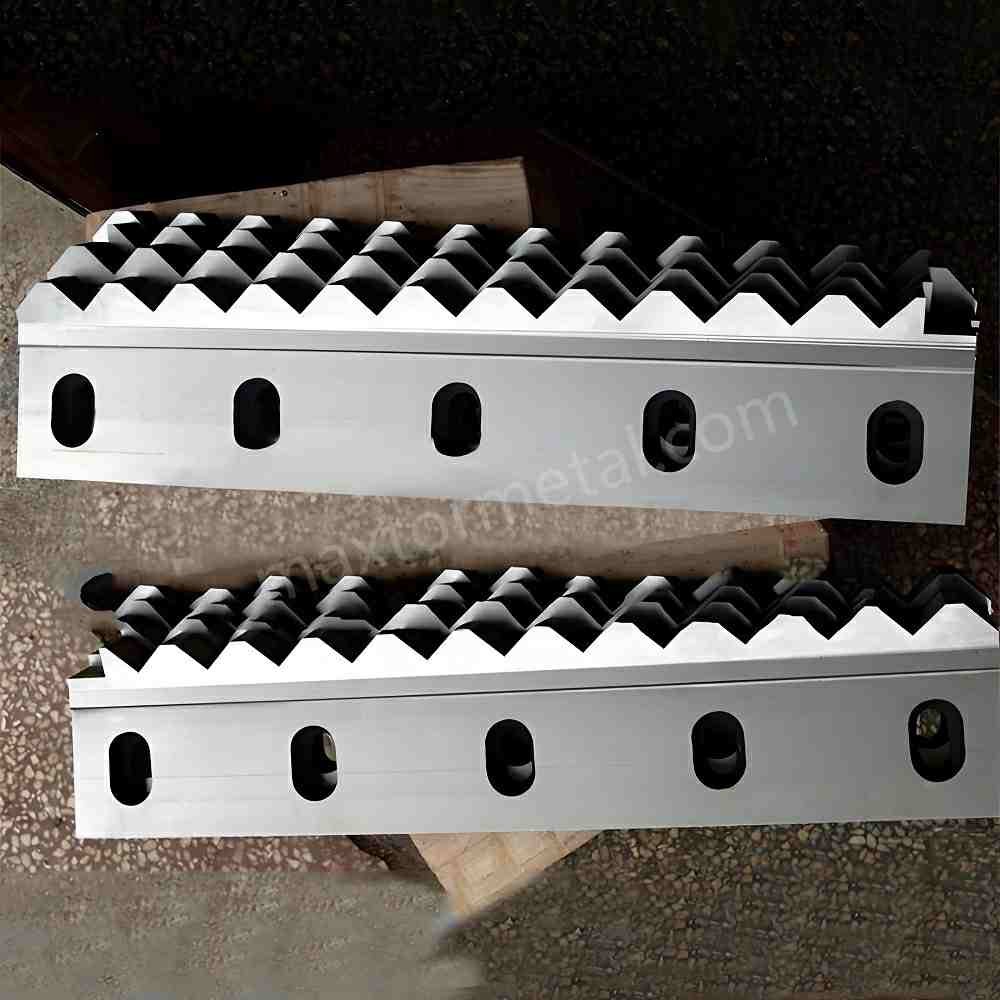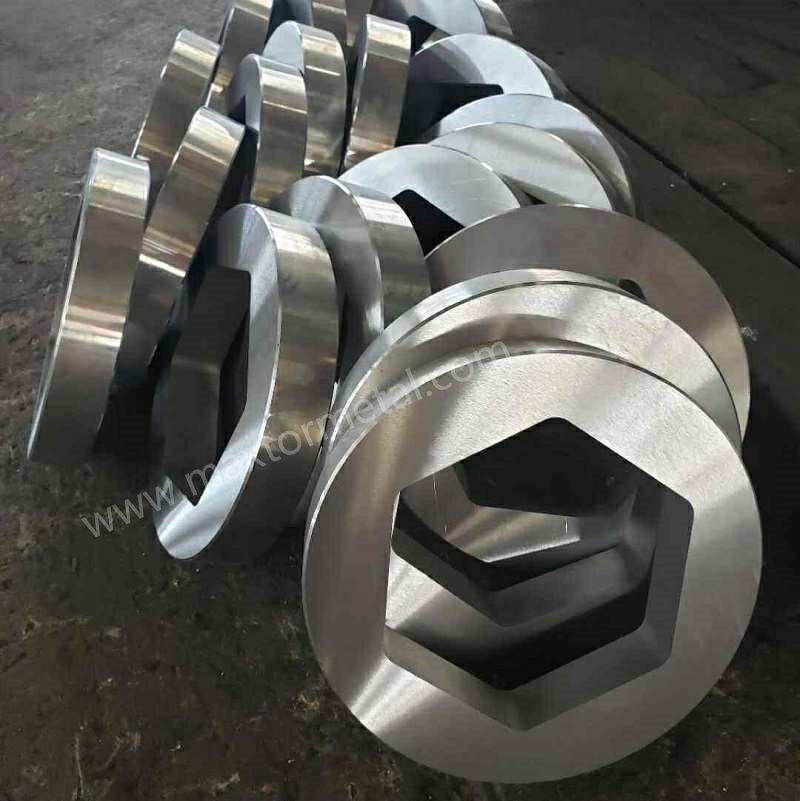
Вы наблюдаете, как необработанная сталь превращается в прочное лезвие измельчителя благодаря тщательной обработке Процесс производства ножей шредераЭтот процесс начинается с выбора подходящего материала. Затем квалифицированные рабочие придают стали форму, нагревают и обрабатывают её. Каждый этап — проектирование, формовка, закалка, полировка и контроль качества — повышает прочность и долговечность лезвия. Поставщики используют эти этапы для обеспечения эффективной работы измельчителей. Нанкин Metal позволяет клиентам индивидуализировать свои потребности и проводит тщательные проверки качества, что делает ее лезвия исключительными.
Ключевые выводы
- Правильный выбор стали очень важен для лезвий измельчителя. Это помогает им служить дольше и работать эффективнее.
- Правильные действия, такие как грубая шлифовка и осторожный нагрев, помогают лезвиям служить дольше.
- Новые методы, такие как лазерная резка и штамповка, делают лезвия более точными и сокращают отходы материала.
- Такие этапы термической обработки, как закалка и отпуск, делают лезвия прочными и жесткими.
- Точная обработка обеспечивает правильный размер и остроту лезвий. Это важно для качественного измельчения.
- Контроль качества на каждом этапе позволяет исключить проблемы и гарантировать бесперебойную работу лезвий.
- Возможность настройки позволяет менять лезвия для особых задач измельчения. Это повышает их эффективность.
- Выбор надежного поставщика означает, что вы получите лезвия, которые прослужат дольше и будут работать лучше.
Выбор материала

Выбор правильного материала — это первый шаг. Это очень важно при изготовлении лезвий для шредера. Необходимо выбрать сталь, подходящую для ваших задач. Выбор стали влияет на срок службы лезвия и на его эффективность.
Типы стали для лезвий шредеров
В измельчителях используются различные виды стали. Каждый из них имеет свои особенности. В таблице ниже перечислены распространённые типы стали. и что они предлагают:
| Тип стали | Механические свойства |
|---|---|
| Легированная инструментальная сталь (D2, M2) | Хорошая прочность, вязкость, высокая твердость и режущая способность. |
| Сплав карбида вольфрама | Исключительная твердость и износостойкость, идеально подходит для твердых и абразивных материалов. |
| Мартенситная нержавеющая сталь | Коррозионная стойкость и твердость, подходит для агрессивных сред. |
| Быстрорежущая сталь (HSS) | Превосходные режущие свойства и износостойкость для материалов средней прочности. |
| Ферритная нержавеющая сталь | Коррозионная стойкость, подходит для использования в пищевой промышленности и медицинском оборудовании. |
| Порошок Metallurgy сталь | Высокая твердость и однородная структура, предпочтительны для высокопрочных и износостойких применений. |
Легированная сталь
Легированная сталь прочна и устойчива к ржавчине. Она хорошо подходит для работы во влажных и химически агрессивных средах. Эта сталь продлевает срок службы лезвий. Она также позволяет лезвиям резать твёрдые материалы.
Нержавеющая сталь
Нержавеющая сталь прочная и устойчива к ржавчине. Мартенситная нержавеющая сталь лучше всего подходит для влажных и грубых поверхностей. Ферритная нержавеющая сталь подходит для измельчителей пищевых продуктов и медицинских изделий.
Первоначальный осмотр
Перед формовкой необходимо проверить сталь. Обратите внимание на трещины и дефекты. Убедитесь, что поверхность ровная. Только лучшая сталь подходит для следующего этапа. Пропуск этой проверки может привести к получению слабых лезвий. Слабые лезвия недолговечны.
Подготовительные этапы
Перед изготовлением клинков необходимо подготовить сталь. В таблице ниже приведены шаги, которые помогут продлить срок службы клинков:
| Подготовительный этап | Влияние на долговечность лезвия |
|---|---|
| Обработка поверхности борированием железа | Значительно повышает износостойкость |
| Переход режима износа | Снижает износ до более низкого стационарного режима |
Чтобы помочь вашим лезвиям, выполните следующие действия:
- Грубая шлифовка позволяет получить лезвие нужного размера.. Этот шаг позволяет лезвию работать лучше и служить дольше.
- Во время отжига необходимо контролировать нагрев и охлаждение. Это предотвращает неравномерную твёрдость и напряжение внутри клинка. Это также повышает его прочность.
Примечание: правильный выбор материала и его правильная подготовка помогут изготовить прочные лезвия измельчителя.
Обработка лезвий шредера

Вырубка и ковка
Обзор процесса
Сначала рабочие формируют заготовки лезвий из сырой стали. Они используют вырубку, чтобы нарезать стальные листы на заготовки грубой формы. Тяжелые прессы давят на сталь. Это формирует базовый контур каждого лезвия. Рабочие внимательно следят за температурой. Высокая температура делает сталь мягкой. Мягкая сталь легче поддается формовке. Необходимо контролировать давление и температуру, чтобы предотвратить появление трещин и слабых мест. Цель — получить заготовку, соответствующую необходимому дизайну и размеру.
Передовые методы ковки Nanjing Metal
Nanjing Metal использует специальные ковочные машины. Датчики постоянно отслеживают температуру и давление. Это обеспечивает прочность и однородность каждой заготовки лезвия. Специальные штампы позволяют выбирать различные формы лезвий. Вы можете выбрать одновальные, двухвальные, четырёхвальные или когтевые конструкции. Каждый штамп соответствует нужному вам типу лезвия. Благодаря этому лезвия прочные и долговечные. Вы получаете лезвия, которые отлично подходят для измельчения.
Лазерная резка
Обзор процесса
После ковки заготовки клинков подвергаются лазерной резке. Мощные лазеры режут сталь с высокой точностью. Траектория реза контролируется компьютерами. Этот этап позволяет экономить материал и сокращать количество отходов. Заготовки клинков имеют точные размеры. Процесс быстрый и чистый. Не требуются химикаты или дополнительная очистка. Вы экономите время и обеспечиваете безопасность рабочей зоны.
Вот таблица, показывающая, как лазерная резка помогает:
| Выгода | Описание |
|---|---|
| Превосходная точность и правильность | Лезвия нарезаются по точным размерам. |
| Автоматизированные процессы и минимизация трудозатрат | Меньше человеческих ошибок, поэтому размеры остаются прежними. |
| Высокоскоростные операции | Новые лезвия изготавливаются быстро. |
| Минимальные требования к постобработке | Меньше отходов и более эффективное использование стали. |
| Чистота | Химикаты не требуются, поэтому резка становится чище. |
Преимущества лазерной резки Nanjing Metal
Nanjing Metal использует современные лазерные станки. Вы можете заказать лезвия специальной формы и узких размеров. Автоматизированный процесс обеспечивает неизменное качество заготовок лезвий. Лезвия идеально подходят для вашего шредера. Эта технология позволяет вам создавать индивидуальные конструкции для различных задач.
Техники штамповки
Обзор процесса
Штамповка добавляет заготовкам лезвий новые характеристики. Станки пробивают отверстия и вырезы в стали. Вы настраиваете станки на повторение одного и того же действия. Этот этап обеспечивает получение лезвий с нужными отверстиями и кромками. Результат всегда одинаков. Штамповка — это быстрый процесс и эффективное использование стали.
В таблице ниже представлены основные преимущества штамповки:
| Преимущество | Описание |
|---|---|
| Высокий коэффициент использования материала | Эффективно использует сталь и производит меньше отходов. |
| Экономия средств | Экономит деньги и снижает производственные затраты. |
Инновации в штамповке от Nanjing Metal
Nanjing Metal использует очень точные штампы. Автоматизированная проверка выявляет ошибки на ранних стадиях. Вы получаете лезвия с теми же характеристиками и меньшим количеством ошибок. Это помогает вам получать лезвия, которые хорошо подходят для шредеров. Вы можете выбрать различные типы и размеры лезвий в соответствии с вашими потребностями.
Формование заготовок лезвий
Обзор процесса
Ключевой этап — формирование заготовок лезвий. На этом этапе сталь приобретает базовую форму лезвия шредера. Рабочие используют станки для обрезки кромок и сглаживания поверхностей. Они проверяют размер и толщину на соответствие проекту. Вы видите, как лезвие начинает приобретать свою окончательную форму. Профилирование кромок задаёт лезвию необходимый угол резания. Сглаживание поверхности устраняет шероховатости. Эти этапы обеспечивают оптимальную посадку лезвия в шредере и снижают трение. Вы получаете заготовку, готовую к дальнейшей обработке.
Совет: Тщательная формовка и сглаживание на этом этапе помогут лезвию измельчителя прослужить дольше и резать лучше.
Возможности настройки Nanjing Metal
Вам может понадобиться лезвие для специальной работы. Компания Nanjing Metal готова вам помочь. Компания использует передовые станки для производства. изготовленное на заказ лезвие Заготовки. Вы можете выбрать размер, толщину и тип кромки. Если вам нужен нож для пластика, дерева или металла, вы можете запросить необходимые характеристики. Команда проверяет каждую заготовку на соответствие вашему заказу. Вы получите лезвие, которое подходит вашему шредеру и вашим потребностям. Такой уровень персонализации подходит для многих отраслей, от переработки до производства.
- Вы выбираете материал и форму.
- Вы сами решаете, сколько у вас будет зубов и когтей.
- Вы можете заказать специальные отверстия или выемки.
Этот процесс дает вам больше контроля над результатами измельчения.
Различия в обработке различных типов лезвий
Не все лезвия для шредеров одинаковы. Для каждого типа требуется свой процесс изготовления. Это видно на примере изготовления одновальных, двухвальных и лезвий с когтями. В таблице ниже показаны некоторые основные различия:
| Тип измельчителя | Тип лезвия | Использованный материал | Возможности обработки |
|---|---|---|---|
| Одновальный | Квадратное лезвие | Cr12MoV, D2, DC53 (HRC60°+) | Мягкие материалы, такие как пластик, дерево |
| Двухвальный | Нож-коготь | 9CrSi, H13, D2, ЛД | Общие материалы, включая пластик, дерево, металлы |
| Четырехвальный | Н/Д | Н/Д | Н/Д |
| Когтистый тип | Нож-коготь | Н/Д | Крупногабаритные отходы, металлолом, резина, древесина |
Вы заметили, что в одновальных измельчителях используются квадратные лезвия. Для мягких материалов такие лезвия требуют прочной стали и тщательной обработки. В двухвальных измельчителях используются ножи-когти. Для этого требуется другой штамп и специальная обработка кромок. Ножи-когти предназначены для крупногабаритных отходов. Им требуется дополнительная обработка и иногда больше зубьев. Каждый тип заготовки лезвия проходит уникальную обработку в соответствии с выполняемой задачей. Это гарантирует, что ваш измельчитель будет хорошо работать с вашим материалом.
Термическая обработка

Термическая обработка очень важна для лезвий измельчителей. Это делает лезвия прочными и жёсткими. Этот процесс изменяет свойства стали, позволяя ей выдерживать тяжёлые условия. Существует три основных этапа: закалка, отпуск и снятие напряжений. Каждый этап продлевает срок службы лезвия и улучшает его работу.
Закалка
Цель и процесс
Закалка — это первый этап. Рабочие нагревают лезвие до очень высоких температур. Сталь внутри изменяется, образуя аустенит. Затем лезвие быстро охлаждают. В результате образуется мартенсит, который очень твёрдый.
Методы контроля температуры и закалки
Рабочие должны следить за температурой и скоростью охлаждения. В таблице ниже показано, как различные методы охлаждения изменяют лезвие:
| Среда закалки | Скорость охлаждения | Эффект на лезвие |
|---|---|---|
| Вода | Очень быстро | Самая высокая твердость, более хрупкий |
| Масло | Умеренный | Хороший баланс твердости и прочности |
| Воздух | Медленный | Меньшая твердость, повышенная прочность |
Рабочие подбирают оптимальный метод охлаждения для каждого лезвия. Закалка в масле обеспечивает оптимальное сочетание твёрдости и прочности. Это продлевает срок службы лезвий.
Влияние на прочность и износостойкость лезвия
Термическая обработка делает лезвия твёрже и прочнее. Лезвия дольше сохраняют остроту. Их не нужно часто затачивать. Они могут резать твёрдые материалы, например, металлическую стружку и камни.
Передовые методы закалки Nanjing Metal
Nanjing Metal использует специальные этапы термообработки. Вы получаете лезвия высокой твёрдости (HRC 58-62). Рабочие тщательно контролируют температуру. Они используют правильный метод охлаждения для каждого вида работ. Эти этапы обеспечивают лезвиям эффективную работу в сложных условиях.
Закалка
Цель и процесс
Отпуск следует за закалкой. Рабочие снова нагревают клинок при более низкой температуре. Этот этап делает клинок менее хрупким и более гибким.
Оптимизация температуры и продолжительности
Мастера должны выбрать правильную температуру и время. Если отпуск слишком долгий, лезвие становится мягким. Если отпуск слишком короткий, лезвие остаётся хрупким. Они используют тщательный контроль, чтобы добиться наилучшего результата.
Баланс твердости и прочности
Закалка делает лезвия твёрдыми, но не ломающимися. Этот баланс необходим для измельчения многих материалов.
Инновации в закалке от Nanjing Metal
На заводе Nanjing Metal используются современные печи для закалки. Вы получаете клинки с оптимальным соотношением твёрдости и прочности. Работники проверяют каждое лезвие, чтобы убедиться в его идеальном качестве.
Снятие стресса
Цель и процесс
Снятие напряжения снимает скрытое напряжение внутри лезвия. Этот этап предотвращает изгиб или деформацию лезвия при использовании.
Методы снижения внутренних напряжений
Работники используют два основных способа:
- Косвенное старение: лезвие обрабатывают на станке, а затем оставляют его в покое.
- Прямое старение: они используют тепло или другие методы для снятия стресса.
Эти способы помогают лезвию сохранять свою форму.
Повышение стабильности и долговечности лезвий
Снятие напряжения делает лезвия прочными и долговечными. Лезвия сохраняют свой размер и хорошо работают в измельчителях.
Процедуры снятия стресса в Nanjing Metal
Nanjing Metal использует передовые методы снятия напряжения. Вы получаете лезвия, соответствующие стандартам конструкции и работающие надёжно.
Совет: Секрет прочности лезвий шредера — термообработка. Они служат дольше и лучше справляются с любыми задачами по измельчению.
Прецизионная обработка

Прецизионная обработка придает каждому лезвию шредера окончательную форму. Лезвие должно быть правильного размера и очень острым. Даже небольшая ошибка может привести к сбоям в работе. Nanjing Metal использует передовые станки, чтобы обеспечить практически одинаковые размеры. Это гарантирует идеальную посадку и быструю резку каждого лезвия.
Шлифовка
Шлифовка — первый этап прецизионной обработки. Она делает лезвие гладким и плоским. Она удаляет шероховатости, полученные на предыдущих этапах.
Плоское шлифование
Шлифовка поверхности делает лезвие плоским и ровным. Заготовку лезвия кладут на магнитный стол. Шлифовальный круг перемещается по лезвию и снимает тонкие слои стали. Это придает лезвию нужную толщину и гладкость. Плоское лезвие плотно входит в измельчитель.
Заточка кромок
Заточка режущей кромки лезвия. Специальные шлифовальные круги делают кромку острой и точной. Острая кромка позволяет лезвию легко резать твёрдые материалы. Она также снижает вероятность застревания или неровных реза. Рабочие осматривают кромку с помощью лупы, чтобы проверить её качество.
Фрезерование
Фрезерование придает лезвию дополнительную форму. Компьютерные станки вырезают канавки, пазы и другие специальные детали в лезвии. Фрезерование также обеспечивает правильный угол режущей кромки. Этот этап важен для лезвий нестандартной формы. Вы можете заказать изготовление лезвий специальной формы или с особыми характеристиками для вашего заказа.
Примечание: Шлифовка и фрезерование позволяют получить размер лезвия максимально приближенным к проекту. Это означает, что каждое лезвие работает одинаково каждый раз.
Вот таблица, показывающая типичные допуски. для лезвий измельчителей в различных отраслях промышленности:
| Промышленность | Рекомендуемая толерантность | Почему это важно |
|---|---|---|
| Упаковка | ±0,05 мм | Обеспечивает высокоскоростную обработку |
| Деревообработка | ±0,10 мм | Обеспечивает гибкость материалов |
Небольшие допуски обеспечивают лучшую посадку и работу лезвия. Высокая точность обеспечивает меньшее дрожание и более плавное измельчение.
Отделка
Финишная обработка — это последний этап прецизионной обработки. Полировка лезвия позволяет удалить мелкие заусенцы и острые края. Этот этап также улучшает внешний вид лезвия и предотвращает появление ржавчины. Рабочие проверяют размер, форму и остроту каждого лезвия. Только качественные лезвия попадают на следующий этап.
- Вы получаете лезвия практически без ошибок в размерах.
- Вы получаете острые лезвия, готовые к тяжелой работе.
Совет: точная обработка продлит срок службы лезвий измельчителя и обеспечит их лучшую работу.
Контроль качества процесса изготовления лезвий шредера

Контроль качества очень важен при производстве лезвий для шредеров. Он гарантирует безопасность и долговечность каждого лезвия. Компания Nanjing Metal многократно проверяет каждое лезвие. Эти проверки помогают предотвратить проблемы до их возникновения. Они также обеспечивают бесперебойную работу вашего шредера.
Инспекция
Сначала рабочие внимательно осматривают каждое лезвие. Они ищут трещины и шероховатости. Они используют штангенциркули и калибры для измерения размеров. Рабочие проверяют остроту и ровность лезвия. Если лезвие неправильное, оно не обрабатывается. Этот этап позволяет выявить ошибки на ранней стадии и сэкономить время в дальнейшем.
- Осмотр лезвия позволяет обнаружить проблемы на поверхности.
- Измерительные инструменты проверяют размер и форму лезвия.
- Проверка кромки позволяет убедиться, что она хорошо режет.
Совет: своевременная проверка поможет вам сэкономить деньги и сохранить ваш шредер в безопасности.
Тестирование производительности
Прежде чем использовать лезвие, необходимо убедиться в его исправности. Рабочие проверяют прочность и остроту лезвия. Они режут им различные предметы. Они проверяют, как долго лезвие остаётся острым. Они также проверяют, какое усилие необходимо приложить для резки.
Испытания проводятся по правилам, принятым во всем мире. Эти правила помогают обеспечить безопасность людей и окружающей среды. В Европе действуют правила ISO, CE и REACH. В Северной Америке и Азии действуют свои собственные правила безопасности. Соблюдение этих правил требует больше времени и средств. Но это помогает предотвратить пожары и травмы.
- Правила безопасности и охраны окружающей среды важны.
- В тестах используются пластмассы, металлы и резина.
- Результаты показывают, соответствует ли лезвие мировым стандартам.
Примечание: соблюдение этих правил обезопасит вас и вашу команду от проблем с лезвиями.
Проверка дефектов
После испытания рабочие снова проверяют лезвие на наличие дефектов. Они используют машины и свои глаза, чтобы обнаружить скрытые трещины. Они ищут такие проблемы, как деформация или неравномерная твёрдость. Если проблема обнаружена, лезвие снимают.
| Тип дефекта | Как это обнаружить | Почему это важно |
|---|---|---|
| Трещины | Визуальный и ультразвуковой | Останавливает внезапные разрывы |
| Деформация | Инструменты измерения | Убедитесь, что он подходит правильно |
| Неравномерная твердость | Твердомеры | Продлевает срок службы лезвия |
Вам нужны лезвия, прошедшие все проверки. Это поможет вам выбрать лезвия для вашего измельчителя, которым вы можете доверять.
Совет: тщательные проверки помогут вам избежать простоев в работе и обеспечить бесперебойную работу измельчителя.
Окончательная сборка

Сборка лезвия
Завершающий этап – сборка лезвия шредера. Рабочие устанавливают каждое лезвие на своё место. Они используют специальные инструменты, чтобы убедиться, что лезвие плотно и ровно сидит. Вы видите, как они проверяют выравнивание и зазоры. Это обеспечивает плавную работу лезвия внутри шредера. Если вам требуется индивидуальное решение, Nanjing Metal предлагает услуги OEM и ODM. Вы можете заказать лезвия, соответствующие вашей машине или особым требованиям. Команда может изменить форму, размер лезвия или монтажные отверстия в соответствии с вашими потребностями.
Контроль качества играет важную роль в процессе сборки. Рабочие используют спектроанализатор для определения марки стали. Они проверяют наличие трещин с помощью ультразвуковой дефектоскопии. Вы можете видеть, как они измеряют размер лезвия и проверяют его твёрдость. В таблице ниже представлены некоторые основные этапы контроля качества:
| Мера контроля качества | Описание |
|---|---|
| Проверка материалов | Анализатор спектра проверяет марку стали. |
| Проверка внутренней структуры | Ультразвуковая дефектоскопия обнаруживает трещины. |
| Комплексная проверка качества | Рабочие измеряют размеры, проверяют твердость и осматривают структуру. |
Совет: тщательная сборка и проверка помогут продлить срок службы лезвий измельчителя и повысить их эффективность.
Покрытие
После сборки рабочие наносят защитное покрытие. Этот слой предотвращает появление ржавчины и износ. Вы можете выбрать различные покрытия для своего лезвия. Некоторые покрытия устойчивы к воздействию химикатов. Другие помогают лезвию дольше оставаться острым. Покрытие также облегчает очистку лезвия. Если вам требуется специальное покрытие для вашей работы, вы можете запросить его. Nanjing Metal может предоставить покрытия, соответствующие вашим потребностям, независимо от того, измельчаете ли вы пластик, дерево или металл.
Рабочие проверяют равномерность покрытия. Они ищут пропуски и пузырьки. Качественное покрытие продлевает срок службы лезвия в сложных условиях.
Упаковка
После того, как лезвие готово, рабочие упаковывают его для отправки. Каждое лезвие упаковывается в защитную пленку, чтобы защитить его от царапин. На каждой упаковке есть этикетки. На этикетках указаны тип лезвия, его размер и номер заказа. Работники прикладывают документы с перечнем характеристик лезвия и результатами проверки. Это поможет вам проверить лезвие по прибытии.
Заказывая у Nanjing Metal, вы получаете помощь с импортом. Команда подготовит все необходимые документы. Вы получите готовые к использованию лезвия в вашем шредере. Упаковка обеспечивает сохранность лезвий во время транспортировки. Вы можете быть уверены, что ваши лезвия будут доставлены в хорошем состоянии.
Примечание: правильная упаковка и документация позволят вам легко отследить свой заказ и сразу же начать использовать новое лезвие.
Оценка лезвий шредеров для поставщиков оборудования

Выбор правильного лезвия для шредера очень важен. Он обеспечивает бесперебойную работу оборудования и способствует успеху вашего бизнеса. Если вы поставщик, вам важно знать, на что обращать внимание при выборе лезвий и компаний-производителей. В этой части мы расскажем, на что обратить внимание, почему важно иметь всегда одинаковые лезвия и как работают хорошие поставщики.
Ключевые показатели качества
Прежде чем выбрать лезвие, обратите внимание на несколько основных характеристик. Они помогут вам понять, подойдёт ли вам лезвие и прослужит ли долго. В таблице ниже перечислены наиболее важные вещи, которые следует проверить.:
| Индикатор | Описание |
|---|---|
| Тип материала | Тип стали или сплава, например, закаленная или с покрытием, влияет на срок службы лезвия. |
| Технология резки | То, как режет лезвие, должно соответствовать тому, что вам нужно измельчить. |
| Требования к техническому обслуживанию | Лезвия, которые легко чистить и ремонтировать, служат дольше. |
| Пропускная способность | Лезвие должно справляться с тем объемом измельчения, который вам необходим в час. |
| Функции безопасности | Обращайте внимание на такие вещи, как охрана и аварийная остановка, для обеспечения безопасности людей. |
| Энергоэффективность | Лезвия, потребляющие меньше энергии, помогают вам экономить деньги. |
| Прочность и долговечность | Качественные материалы и прочная конструкция гарантируют, что лезвие прослужит дольше. |
Совет: Всегда выбирайте лезвие из подходящего материала и с правильным стилем резки для ваших отходов. Это поможет вам добиться лучших результатов и предотвратит преждевременный износ лезвия.
Последовательность
Одинаковая конструкция лезвий помогает вашему измельчителю работать эффективнее. Использование высококачественных лезвий обеспечивает более качественную резку и снижает количество проблем. Вот несколько причин, почему это важно:
- Хорошие лезвия режут хорошо, поэтому ваш измельчитель работает плавно.
- Лезвия, которые всегда одинаковы, не требуют частой замены, поэтому вы экономите деньги.
- Прочные лезвия позволят вашей бригаде работать дольше, не останавливаясь на ремонт.
- Лезвия из прочных материалов служат дольше и не изнашиваются быстро, что экономит ваши деньги.
Убедитесь, что компания использует качественные станки и тщательно проверяет каждое лезвие. Это поможет вам получить лезвия, которые всегда будут работать одинаково хорошо.
Практики поставщиков
Лучшие поставщики делают всё возможное, чтобы вы получали качественные лезвия и обслуживание. При выборе поставщика обратите внимание на следующие моменты:
- Они тратят деньги на новые идеи, чтобы сделать лезвия лучше и эффективнее.
- Они используют качественные материалы и проверяют каждое лезвие, чтобы убедиться в его прочности и остроте.
- Они заботятся об окружающей среде, сокращая отходы и экономя энергию.
- Они помогут вам с поддержкой и фиксацией, чтобы вы могли пользоваться лезвиями в течение длительного времени.
Нанкин Metal Компания особенна тем, что предлагает более 3000 типов лезвий для самых разных задач. Компания использует современное оборудование и проводит строгие испытания, чтобы гарантировать, что каждое лезвие служит дольше большинства других. Вы также можете заказать специальные лезвия, соответствующие вашим потребностям, что поможет вашему бизнесу работать эффективнее.
Примечание: если вы выберете поставщика, который делает все это, вы получите лезвия, которые помогут вашему измельчителю работать лучше и со временем сэкономят вам деньги.
Вы увидите, насколько важен каждый этап изготовления лезвий для шредера. Выбор качественных материалов, тщательное изготовление лезвий и контроль качества гарантируют бесперебойную работу вашего шредера. Каждый этап гарантирует прочность и долгий срок службы лезвий.
- Лезвия дольше остаются острыми и обеспечивают более чистый срез.
- Вы можете быть уверены, что процесс изготовления лезвий измельчителя даст хорошие результаты.
Хотите узнать больше или узнать цену? Свяжитесь с нашей командой за помощью к экспертам.
Часто задаваемые вопросы
Какие материалы вы используете для лезвий измельчителей?
Производители используют легированную, нержавеющую и инструментальную сталь. Эти материалы обеспечивают прочность лезвий и обеспечивают их качественную резку. Вы можете выбрать оптимальный материал для ваших задач по измельчению.
Как поддерживать остроту лезвий измельчителя?
Шлифовальные и фрезерные станки затачивают лезвия. Рабочие рассматривают кромку с помощью луп. Заточка часто позволяет лезвиям работать максимально эффективно.
Можете ли вы изготовить лезвия измельчителя по индивидуальному заказу для моей машины?
Вы можете запросить лезвия специальной формы, размера и характеристик. Современные машины помогут подобрать лезвия к вашему измельчителю. Вы получите лезвия, которые идеально подойдут к вашему устройству.
Как проверяется качество лезвий измельчителя?
Рабочие проверяют лезвия на наличие трещин и измеряют их размер. Они испытывают лезвия, разрезая различные материалы. Контроль качества гарантирует, что вы получите лезвия, которым можно доверять.
Какие покрытия доступны для лезвий измельчителей?
Вы можете выбрать покрытия, защищающие лезвия от ржавчины, воздействия химикатов и износа. Такие покрытия продлевают срок службы лезвий и упрощают их чистку.
Как вы упаковываете лезвия шредера для транспортировки?
Лезвия упакованы для защиты от царапин. Каждая упаковка снабжена этикетками и документами. Хорошая упаковка обеспечивает сохранность лезвий при транспортировке.
Как часто следует менять лезвия измельчителя?
Заменяйте лезвия, если они затупились или плохо режут. Регулярные проверки помогут вам определить, когда пора менять лезвия.
Совет: Всегда следуйте рекомендациям производителя по уходу за лезвиями и их замене. Это обеспечит безопасность и бесперебойную работу измельчителя.
Смотрите также
Основные Характеристики Ножей Шредера для Электронных Отходов для Безопасного Уничтожения
Как Выбрать Ножи для Шредера Пластика для Эффективной Переработки
Полное Руководство по Конструкциям Ножей Одновального Шредера
Лезвия измельчителя: анализ классификации, выбор материала, срок службы и методы проектирования


